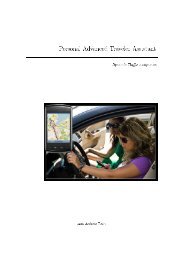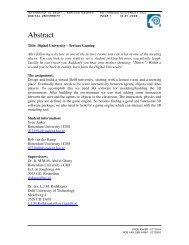Neural Flight Control Autopilot System - Knowledge Based Systems ...
Neural Flight Control Autopilot System - Knowledge Based Systems ...
Neural Flight Control Autopilot System - Knowledge Based Systems ...
Create successful ePaper yourself
Turn your PDF publications into a flip-book with our unique Google optimized e-Paper software.
Figure 12 shows the altitude and pitch error during a<br />
flight were the aircraft flew up to 2000 feet, then up to<br />
4000 feet, and again down to 2500 feet. The red line in the<br />
lower part of Figure 12 shows the actual pitch output value<br />
while the blue line is used to visualize the desired pitch<br />
output value. From the comparison we can see that the<br />
neural controller can respond to changes of the desired<br />
pitch value immediately. In another words, the controller<br />
has fast reaction ability.<br />
6.2. <strong>Control</strong>ler stability analysis<br />
There are several ways to analyse the stability of the<br />
controller. For example, we may characterize stability<br />
from an input-output viewpoint, or we can characterize<br />
stability by studying the asymptotic behaviour of the state<br />
of the system near steady-state solutions, like equilibrium<br />
points. We prefer to use the steady-state stability analysis,<br />
so we studied if the current system is asymptotic stable<br />
and characterized the attraction region.<br />
• <strong>Control</strong> the airplane to take off, fly up and fly down;<br />
• Run alongside the Microsoft <strong>Flight</strong> Simulator,<br />
which is a large CPU time consuming application;<br />
• <strong>Control</strong> the airplane so that it achieves a stable<br />
flight;<br />
• Respond to the changes of the desired plant output<br />
immediately;<br />
• Provide the current flight situation to the user and<br />
visualize the evaluation data in 2D coordinates in<br />
real time.<br />
The test results also show that the training of the<br />
controller neural network is affected by the pre-defined<br />
desired plant output. Therefore, setting the proper desired<br />
plant output for each flight procedure is very crucial for a<br />
good controller system.<br />
As mentioned before, one of our improvements was to<br />
limit the output range of the elevator control to decrease<br />
the “wobbling” pitching magnitude, but this phenomenon<br />
still occurs (to a much smaller extent) at the beginning of<br />
each flight procedure. It does disappear as training<br />
progresses, as can be seen in Figure 15.<br />
Figure 13: elevator (left) and throttle input (right) during the<br />
flying up procedure<br />
Figure 15: normalized elevator input (left) and pitch value (right)<br />
during flying up procedure<br />
Figure 14: pitch (left) and the airspeed output (right)<br />
corresponding to Figure 13<br />
Figure 13 shows that at the start of the control phase<br />
both the elevator input and the throttle input start with an<br />
arbitrary value. As the process goes on, both slowly settle<br />
on a certain value to achieve the desired pitch and airspeed<br />
output. Figure 14 includes the corresponding pitch value<br />
and the airspeed value taken from the elevator control<br />
input and the throttle control input.<br />
With a smaller input the output will be smaller also, and<br />
the control inputs will finally settle on a certain value to<br />
achieve a certain desired output. These two characteristics<br />
indicate that this control system is asymptotic stable.<br />
7. CONCLUSIONS AND DISCUSSION<br />
7.1. Conclusions<br />
The results presented in the previous chapter<br />
demonstrate that the current neural flight controller system<br />
can:<br />
Figure 16: altitude corresponding to Figure 15<br />
7.2. Discussion<br />
Unfortunately, the “wobbling” pitch phenomena cannot<br />
be avoided if we stick to the continuous online training of<br />
the single neural controller system that we use. However,<br />
we feel that this is not a big problem, since this<br />
phenomenon can also be found in normal piloting<br />
behaviour, which we ultimately intend to simulate.<br />
Figure 16 shows that the overall change in altitude<br />
progresses as normal and small variations are only visible<br />
on closer inspection.
















